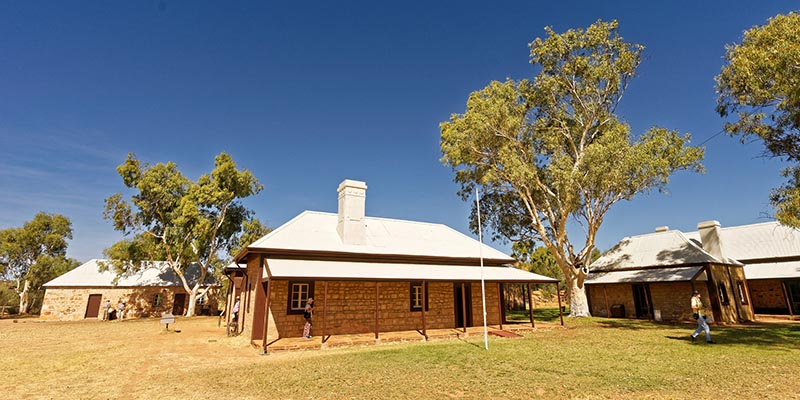The Telegraph Station

Herbert Heritage Drive, Stuart NT 0870, Australia +61 8 8952 3993 Website 9am – 5pm Alice Springs Campervan Hire
stationantlia (contributor)
The Telegraph Station is the oldest building in Alice Springs. It is a bit out of town. We walked to it via the dried out Todd River bed.
The telegraph station enabled telegraphic communication between Adelaide and Darwin. The station is now a museum with old photos and telegraphic equipment. I found it interesting.
mousellinespiky (contributor)
The history of Alice Springs revolves around a single piece of wire that stretched from Darwin to Adelaide and carried the all important telegraph messages. Perhaps in these days of instantaneous communication with anywhere in the world via satellite and other types of transmission, the idea of the telegraph does sound totally alien – men sitting at desks pounding out messages one fingered on their Morse keys to be relayed to another operator about 250 km away and repeated over several hours across Australia. I used to be in the Scouting movement many years ago and did learn Morse code. Later for a short time I was in the Citizens Military Forces (CMF and now called the Army Reserve) and in the signals section – I became a signaler and as such did know and use Morse code – although I was very slow.
To give you an example of how long it would take for a message to be transmitted from Darwin to Adelaide, the most proficient Morse operators could send/receive messages at about 40 wpm (words per minute). The first paragraph above is 140 words and therefore would take 3.5 minutes to send/receive. The line was 3200 km from Darwin to Adelaide and had 11 repeater stations plus a ‘terminus’ at each end. Thus the above paragraph would have taken 3.5 minutes x 12 = 42 minutes to be sent and received.
The Alice Springs Telegraph Station is located 4 km from Alice Springs Township and is a well-preserved monument to those who constructed the line, which was completed in 1872 and to those who sat on keyboards receiving and sending messages across the void of desert until its closure after 60 years in 1932. The subsequent history of the station – it became a church mission dedicated to caring for and educating Aboriginal children. One of many panels in the interior of the building states, “They just take you out of your mother’s arms.” Sad times and the basis for ‘SORRY’ as expressed in Federal Parliament.
With my own experiences using Morse code, I was particularly fascinated with the post and telegraph office where much of the earlier equipment was on display and, importantly, in full working order. They even had a taped message and the all-pervading sound of dit, dah, dit etc but at a very rapid rate – the sort of rate that an experienced operator would be able to send/receive messages.
On an interpretive panel, a poignant reminder of the hard work read, “Every word of the world news passed through the Alice Springs telegraph office.”
Sadly our time at the Telegraph Station was very short and I would think you should allow 3 + hours to really enjoy – and far more if you are an ex-signaler. On the off chance that you are, I hope you remember the ditty we used to sing out in a bawdy mess room fashion after far too much beer, “Dit dah dit said the signalman, merry, merry men are we . . . “
To help you with research here are 2 links – Australian Overland Telegraph Line and Morse code
instructvalues (contributor)
The Old Alice Springs Telegraph Station (ASTS) was the fourth stop (of five) on our Discover a Town Like Alice Tour. Because of the availability of water, for thousands of years the Arrernte people met at this site for ceremonies and to exchange goods. Mostly because of the same reason, the ASTS was the first white settlement in Central Australia. The telegraph station (1880 photo) was operational from 1872 – 1932. It became a children’s home called The Bungalow from 1932 – 1942, and subsequently a reserve for the local Aboriginal population after World War II until 1960. The telegraph station was declared a historical reserve in 1963. The buildings have been restored to how they looked in the 1895 – 1905 timeframe. The site includes the stationmaster’s house (built in 1888), the stationmaster’s kitchen (originally a post and telegraph office built in 1877, opening in January 1898; converted to a kitchen in late 1880’s), the post and telegraph office (built in late 1880’s), the barracks (oldest building in Central Australia; built in November 1871), the battery room (originally sleeping quarters for linesmen in 1880, then batteries in 1886, and schoolroom in 1932), and a storage and buggy shed (built in early 1870’s).
Unfortunately our tour was running late and we only had 30 minutes to spend at ASTS. I did do the Waterhole Walk (75 m, 10 min return from the Blacksmith Shop); however, there was another walk that I would like to have done. It was the Trig Hill Walk (1.2 km, 30 min return) which goes to the high point in the Reserve and has views of ASTS compound, Todd River and MacDonnell Ranges. Actually the ASTS is only ~3 km north of the Todd Mall up the river. In fact the old road used to go north at Hartley Street on the west side of the river, cross the river and go through the grassy flat called Middle Park on the east side of the river, and then cross back over to the west side about 500 m south of ASTS.

 English
English
